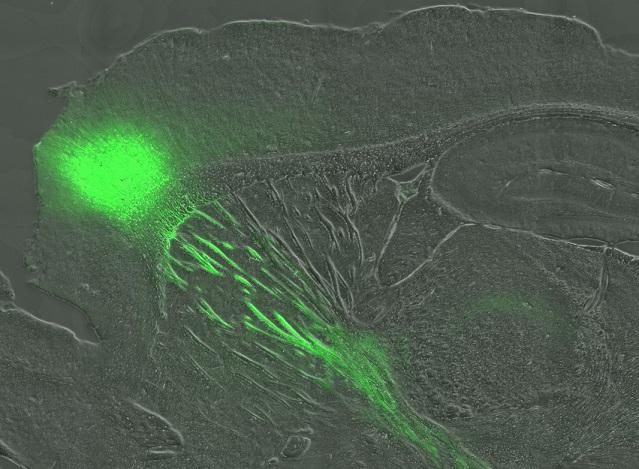Optogenetic stimulation improves alterations in Huntington’s disease experimental models

By administrating the opsin gen (green) to the brain cortex, we can selectively activate the neuronal terminals in the striatum, which express the protein. This stimulation enabled an improvement in the symptoms in the experimental model of Huntington's disease.
Photo: Sara Conde Berriozabal
Huntington’s disease is an hereditary neurodegenerative disease featured by alterations in movement, cognitive deficiency and psychiatric disorders resulting from the degeneration of neurons in the striatum nucleus of the brain. A study led by researchers of the Institute of Neurosciences of the UB (UBNeuro) has characterized one of the neuronal circuits involved in the development of the disease: the connection of the secondary motor cortex (M2) in the dorsolateral striatum nucleus (DSL).
The study, published in the journal eLife, shows in an animal model with the pathology, that optogenetic stimulation of the circuit causes improvements in the typical symptomatology of the disease. According to the researchers, these results shed light to other pathologies with similar traits such as Parkinson’s disease and Tourette’s syndrome.
The study is led by Mercè Masana, tenure track-1 lecturer at the Faculty of Medicine of the UB and researcher at UBNeuro, IDIBAPS and the Biomedical Research Networking Center in Neurodegenerative Diseases (CIBERNED). The study counts on the participation of the lecturers and researchers from the same faculty Jordi Alberch and Manuel José Rodríguez (UBNeuro-IDIBAPS), and David Bernal-Casas, from the Faculty of Biology of the UB. Among other participants are also the researchers from the Institute of Biomedical Research of Barcelona (IIBB-CSIC), the Biomedical Research Networking Center in Mental Health (CIBERSAM) and the IDIBAPS Magnetic Resonance Imaging Unit.
Alterations in the connection between the cortex and the brain striatum
The aim of this study was to analyse the alterations in the brain circuits that cause neurological symptoms in Huntington’s disease. In collaboration with the IDIBAPS Magnetic Resonance Imaging Unit, researchers used this technology to analyse functional alterations in the circuits that connect the brain cortex to the striatum nucleus of basal ganglia, which plays an important role in the control of the movement and behaviour. “The results of the first analysis in an animal model with symptoms of the disease showed that the functional connectivity of the brain cortex with the striatum nucleus is highly altered”, notes Mercè Masana.
“After this -continues the expert-, we studied in detail a specific circuit that, according to previous studies, shows structural alterations in this disease: the connection of the secondary motor cortex with the dorsolateral striatum”.
To study the function of this circuit, researchers used optogenetics, a powerful and innovative technique that combines genetic and optic methods to boost selectively brain circuits through light. Opsins, proteins from a type of algae, develop channels of photosensitive ions which open when they receive flashes of blue light, and enable the activation of neurons. By administrating the opsin gene to the brain cortex, the neuronal terminals can be selectively activated in the striatum nucleus, and these express the protein. “Using optogenetics, combined with electrophysiology and microdialysis, we could determine that the M2-DLS circuit in the model with Huntington’s disease released reduced glutamate levels, the main neurotransmitter involved in this circuit, and that neurons in the striatum nucleus did not respond to the circuit activation”, notes the researcher.
Increase in synaptic plasticity and reversion of symptoms
Later, researchers used optogenetics again to boost the altered circuit repeatedly. The results show that this stimulation improves the symptomatology in model mice of the disease. “After applying this technique we saw the typical motor symptoms of the pathology reversed, a situation that was joined by a restoration of the synaptic plasticity of the stimulated circuit”, notes Mercè Masana.
Although its application in humans is far from happening yet, the success of this experiment leads to a potential therapeutic strategy based on the restoration of neuronal circuits. “The new study shows that optogenetics could be a powerful tool for the treatment of diseases in which brain circuit activity is altered, and in the future, it could lead to new therapeutic approaches similar to the deep brain stimulation, which is used in Parkinson’s disease”, concludes the researcher.
Huntington’s disease affects more than 4,000 people in Spain and more than 15,000 people are at the risk of having inherited the gen of the disease because they have a family member who is affected by it. At the moment there is no cure for the disease, and there are only treatments aimed at alleviating its symptoms.
All latest news from the category: Health and Medicine
This subject area encompasses research and studies in the field of human medicine.
Among the wide-ranging list of topics covered here are anesthesiology, anatomy, surgery, human genetics, hygiene and environmental medicine, internal medicine, neurology, pharmacology, physiology, urology and dental medicine.
Newest articles

You are What You Eat—Stanford Study Links Fiber to Anti-Cancer Gene Modulation
The Fiber Gap: A Growing Concern in American Diets Fiber is well known to be an important part of a healthy diet, yet less than 10% of Americans eat the minimum recommended…

Trust Your Gut—RNA-Protein Discovery for Better Immunity
HIRI researchers uncover control mechanisms of polysaccharide utilization in Bacteroides thetaiotaomicron. Researchers at the Helmholtz Institute for RNA-based Infection Research (HIRI) and the Julius-Maximilians-Universität (JMU) in Würzburg have identified a…

ASXL1 Mutation: The Hidden Trigger Behind Blood Cancers and Inflammation
Scientists show how a mutated gene harms red and white blood cells. LA JOLLA, CA—Scientists at La Jolla Institute for Immunology (LJI) have discovered how a mutated gene kicks off…



